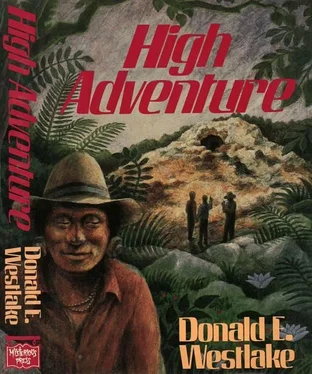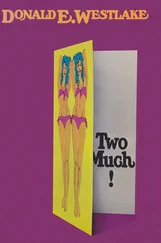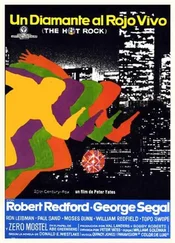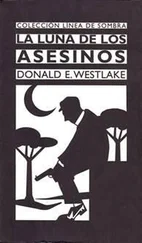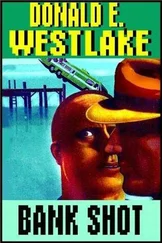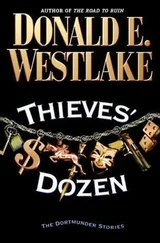Donald E. Westlake
High Adventure
This rumpus is for
Emory and Elisa King, and for
Stewart and Lita Krohn, and for
Compton Fairweather, all of whom
may recognize a tree or two in passing;
and for Abby Adams,
who walked this line.

“Hey, Dad, This Is Belize!”, by Emory King Copyright 1977, Emory King Tropical Books, Belize City, Belize used by permission of the author
Beka Lamb, by Zee Edgell Copyright 1982, Zee Edgell Heinemann Educational Books, Ltd, London used by permission of the author and Heinemann Educational Books
from HEY DAD, THIS IS BELIZE! by Emory King (abridged)
The Atayde Brothers Circus visited Belize in the late twenties. It was around the same time Lindbergh flew into Belize City with his famous plane. They set up their tent near Memorial Park, and when the people of Belize saw what was inside they rushed the place by the thousands.
Animals! Boys, there were elephants, camels, show horses, polar bears, lions, tigers from India, and even giraffes. On the 10th of September the circus band marched through the streets and we almost had a riot.
And a regular band it was too. All the members had uniforms with gold braid and wore high hats and marched like soldiers. The leader of the band was a Mexican Army Major named Ismael G. Amaton. He was on the wrong side in some revolution in Mexico in those days and had been forced to run away and join the circus to keep from being killed.
Every weekend people came from all over to see the circus. There were clowns, performing horses, acrobats from El Salvador, trapeze artists, beautiful German girls dressed all in spangles and tights, who rode bicycles. It was a sight for the people of Belize.
Well boys, the circus stayed around Belize City for about two months, giving shows every weekend to packed audiences. But a funny thing happened. The circus went broke.
Nobody knows why. Maybe someone ran off with the cash. But the circus did not have the money to move on. Little by little, a few of the circus people left. Some went to Honduras and Guatemala. Some went back to Mexico. A few stayed on in Belize.
When there was only about 50 people left, with all the animals and equipment, they decided to sell what they could and rent a boat to take them to Progresso.
A storm came up when the boat, which looked like Noah’s Ark, got as far as Caye Caulker’s northern point. They could not go out to sea, so they came up to San Pedro and landed.
Well, if you ever saw a circus it was that day. The boat got as close to shore as possible, and they put the poor beasts into the sea to get ashore as best they could.
It was a downhearted bunch of people and a sad bunch of animals. Imagine giraffes and elephants, and dancing horses on the beach.
Of course, we villagers did everything we could to help. Water and meat and food for the animals soon put the town in trouble, but somehow we fixed them up alright. The circus people were nice, and put on a couple of shows for us in the main park.
Oh those were the days, boys. Ever since then, whenever we Belizeans hear of a big project that is going to do great things in the country, we say: Bigger circus than this come to Belize and broke up.
Part One
The Famous Plane
The girl was a real pest. “I think it’s terrible,” she said.
Kirby Galway nodded. “I think so, too,” he murmured, jiggling ice cubes in his glass. Around them the party brisked along, intense meaningless conversation on all sides, mammoth paintings of house parts — a keyhole, a windowsill — visible above and between all those talking heads. In the middle distance, receding ever farther from Kirby’s grasp, was his target of opportunity for this evening, one Whitman Lemuel, assistant curator of the Duluth Museum of Pre-Columbian Art, here in New York on a buying expedition, here at this Soho gallery party as a form of relaxation and a story to tell the home folks in Duluth.
Kirby had just this morning learned of Lemuel’s presence in New York, had burrowed out Lemuel’s evening plans by late this afternoon, and had come down through the snowy city to crash the party early, so as to be ready when his mark arrived. Tall and handsome and self-assured, proud of his luxuriant ginger moustache, dressed with casual impeccability, Kirby was yet to find the party he couldn’t crash. And in Soho? He could have come here straight from the jungle, in his hiking boots and oil-stained khakis and battered bush hat, and still they would have swept him right on in, assuming he was either an artist or an artist’s boyfriend.
He was neither. He was a salesman, and his customer this evening was one Whitman Lemuel.
Or was to have been; things were looking decidedly worse. Was it the door Lemuel now angled toward?
It had begun well. Kirby had introduced himself in tried-and-true fashion, by actually introducing the other fellow: “Aren’t you Whitman Lemuel?”
Non-famous people are always delighted to be recognized by strangers. “Why, yes, I am,” said the round-faced Lemuel, eyes benign behind round glasses, broad mouth smiling over polka-dot bow tie.
“I want you to know,” Kirby said, “I was really impressed by that upper Amazon show you put together a while back.”
“Oh, yes?” The smile grew broader, the eyes more benign, the bow tie brighter. “Did you see it in Duluth?”
“Unfortunately not. In Houston. It traveled very well.”
“Yes, it did, really,” Lemuel agreed, nodding, but his expression very faintly clouded. “Still, there were parts of it that couldn’t leave the museum, simply not. I’m afraid you didn’t get the full effect.”
“What I saw was definitely impressive. I’m Kirby Galway, by the way.”
As they shook hands, Lemuel said, “Are you connected with the Houston museum?”
“No, no, I’m merely an amateur, an enthusiast. I live in Belize now, you see, and—”
“Ah, Belize!” Lemuel said, brightening even more.
“You know it?” Kirby asked, with an innocent smile. “Most people’ve never heard of the place.”
“Oh, my dear fellow,” Lemuel said. “Belize. Formerly British Honduras, independent, now, I believe—”
“Very.”
“But, I tell you, Mister, umm...”
“Galway. Kirby Galway.”
“Mister Galway,” Lemuel said, excitement making him bob slightly on the balls of his feet, “I tell you, Belize is fascinating. To me, to someone in my position, fascinating.”
“Oh, really?” Kirby said. His smile said, fancy that.
“It’s the very center, ” Lemuel said, gesturing, slopping his drink on his wrist, not noticing, “the very center of the ancient Mayan world.”
“Oh, it can’t be,” Kirby said, frowning. “I thought Mexico was—”
“Aztecs, Aztecs,” Lemuel said, brushing those Johnny-come-latelys aside. “Olmecs, Toltecs,” he grudgingly acknowledged, “but comparatively little Mayan.”
“Guatemala, then,” Kirby suggested. “There’s that place, what is it, Tikal, where they—”
“Of course, of course.” Lemuel’s impatience was on the wax. “Until very recently, we thought those were the primary Mayan sites, that’s true enough, true enough. But that’s because no one had studied Belize, no one knew what was in those jungles.”
“Now they do?”
“We’re beginning to,” Lemuel said. “Now we know the Mayan civilization covered a great crescent shape, extending from Mexico south and west into Guatemala. But do you know where the very center of that crescent is?”
Читать дальше
